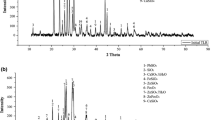The research subject is an intermediate product of zinc production containing lead, zinc, iron, copper, and silver. Thermodynamic analysis is performed for all probable transformations during sulfuric acid leaching, and a Purbe diagram is plotted. The study of uncovering lead-containing middlings is performed in two stages: the first is leaching with sulfuric acid with density 250 g/dm3 (S:L = 1:4) at 80°C for 2 h. At the second stage, washed cake is leached with a complexing solution (Trilon B) with the aim of maximum zinc transfer into the liquid phase. Conditions are selected on the basis of test results for process optimization by an experimental planning method, and from analysis of response surface, modeling the dependence of the degree of leaching on pulp density and complexing agent concentration.


Similar content being viewed by others
References
L. A. Kazanbaev, P. A. Kozlov, and V. A. Kubasov, Zinc Hydrometallurgy. Leaching Processes, Ruda i Metally, Moscow (2007).
S. G. Strupnikov and Yu. A. Koz’min, “Hydrometallurgical processing schemes for lead concentrates,” Khim. Interes. Ustoich. Razvit., No. 13, 483–490 (2005).
E. V. Margulis and N. V. Khodov, “Hydrometallurgical extraction of lead from lead cakes and dust,” Tsvetn. Met., No. 6, 29–30 (1990).
R. Raghavan, P. K. Mohanan, and S. R. Swarnkar, “Hydrometallurgical processing of lead-bearing materials for the recovery of lead and silver as lead concentrate and lead metal,” Hydrometallurgy, 58, No. 2, 103–116 (2000).
L. C. Ferracin, A. E. Chacon-Sanhueza, R. O. Davoglio, et al., “Lead recovery from a typical Brazilian sludge of exhausted lead-acid batteries using an electrohydrometallurgical process,” Hydrometallurgy, 65, No. 2/3, 137–144 (2002).
A. V. Tarasov (ed.), A. D. Besser, V. I. Mal’tsev, and V. S. Sorokina, Metallurgical Processing of Secondary Lead Raw Material, Gintsvetmet, Moscow (2003).
V. A. Sergeev, Comprehensive Processing of Lead-Containing Zinc Industry Intermediate Products: Dissert. Cand. Techn. Sci., Ekaterinburg (2009).
S. V. Karelov, O. S. Anisimova, S. V. Mamyachenkov, and V. A. Sergeev, “Leaching of the lead cakes of zinc production in the complex solvent,” Russ. J. Non-Ferr. Met., No. 2, 20–25 (2009).
A. D. Besser and A. V. Tarasov, “Application of direct current electric furnaces in the metallurgy of heavy non-ferrous metals,” Proc. 6th Int. Conf. Recycling Lead and Zinc into the 21st Century, Madrid, Spain, June 18–23, 1995 (1995), Suppl. Vol. ILZSG, pp. 237–238.
Author information
Authors and Affiliations
Corresponding author
Additional information
Translated from Metallurg, No. 8, pp. 94–96, August, 2015.
Rights and permissions
About this article
Cite this article
Shaimardan, N., Kulenova, N.A., Mamyachenkov, S.V. et al. Study of Zinc-Lead-Containing Cake Leaching Features. Metallurgist 59, 740–743 (2015). https://doi.org/10.1007/s11015-015-0168-4
Received:
Published:
Issue Date:
DOI: https://doi.org/10.1007/s11015-015-0168-4



